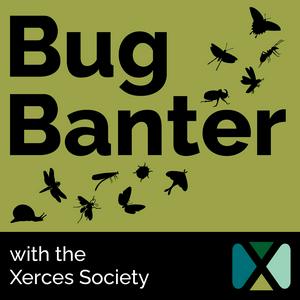Episódios Disponíveis
5 de 56
- A Year in Invertebrate Conservation: Successes and the Road AheadOver the past year, we’ve explored a diversity of invertebrates, the threats they face, and the ways we can help support them. In this episode, we’ll take a closer look at invertebrate conservation—reflecting on this year’s successes and achievements, as well as the challenges that lie ahead. What victories can we celebrate, and which conservation efforts must continue? What obstacles do we, as invertebrate enthusiasts, still face? Most importantly, what actions can people take right now to make a lasting difference?Who better to talk about this topic than Xerces Society executive director, Scott Black. Scott has led the Xerces Society for a quarter century, during which time Xerces has grown and become internationally recognized for its work. Scott himself is a renowned conservationist whose work has led to protection and restoration of habitat on millions of acres of rangelands, forests, and farmland, as well as protection for many endangered species.---Photo: Sara Morris/CC BY-NC 2.0Thank you for listening! For more information go to xerces.org/bugbanter.--------51:22
- Hidden in Plain Sight: Pesticide Contamination in Butterfly Host PlantsThe State of the Butterflies in the United States project demonstrated that butterfly populations across the US are dramatically declining — they fell by more than 20% between the year 2000 and 2020. There are multiple causes, but one of them is the loss of caterpillar host plants. Getting more host plants into our neighborhoods and parks is essential — but what happens if those plants are contaminated by pesticides and they are toxic to the caterpillars that need them?To talk more about this conundrum is Aaron Anderson. Aaron is no stranger to Bug Banter listeners. Aaron is a member of Xerces’ pesticide reduction team, where his work focuses on reducing pesticide use in residential landscapes, including promoting alternative pest-control measures and pollinator-friendly gardening practices. More pertinently, he recently was a coauthor on a study of pesticide contamination of butterfly host plants.---Photo Credit: Kevin BurlsThank you for listening! For more information go to xerces.org/bugbanter.--------29:45
- Adaptations at Altitude: The Biology of Mountain SnailsGiven the name of our podcast, it is no surprise that we talk a lot about bugs, but in this episode, we are stretching our invertebrate muscles and looking at a group of invertebrates that we haven’t considered before—mountain snails! To help us learn more about these fascinating animals is Dr. Lusha Tronstad. Lusha is the Invertebrate Zoology Program Manager for the Wyoming Natural Diversity Database at the University of Wyoming. The WNDD program is responsible for developing and maintaining data on the distribution, natural history, conservation status, and habitat requirements of rare invertebrate species in the state. Lusha has a Ph.D. in Zoology and Physiology from University of Wyoming and is interested in food webs, invasive species, conservation, bioassessment and biogeochemistry, while working in aquatic ecosystems and with pollinators.---Photo: Lusha TronstadThank you for listening! For more information go to xerces.org/bugbanter.--------27:19
- The Secret Lives of Bumble Bees: Nesting and OverwinteringWe’ve all heard the familiar buzz of a bumble bee. Their fuzzy bodies fly around looking for pollen and nectar. But where do bumble bees nest? Where do they spend the winter? And how can we support this part of their lifecycle?To talk with us about this topic is Genevieve Pugesek, Xerces Endangered Species Conservation Biologist. Jenny is one of the project managers of the Bumble Bee Atlas, a community science project aimed at tracking and conserving bumble bees. She works with Atlas programs in Missouri, Nebraska, Iowa, and Minnesota. She is broadly interested in conservation biology, land management, and animal natural history. She earned her Ph.D. at Tufts University, where she studied the nesting and overwintering ecology of bumble bees.---Photo: Kent McFarland Flickr CC 2.0Thank you for listening! For more information go to xerces.org/bugbanter.--------37:08
- The Salmonfly Project: Anglers, Insect Conservation, and the Future of Freshwater StreamsInsects play a critical role in rivers, lakes, and streams, acting as a vital food source for many animals and maintaining the health of these freshwater ecosystems. A few of these insects include: mayflies, stoneflies, and caddisflies. The bad news? They are in decline. The good news? There is something we can do about it. This is a new topic for us and one that we are excited to explore.Joining us to dive into the aquatic world are Jackson Birrell and James Frakes, co-founders of the Salmonfly Project, which is based here in Missoula, Montana and aims to conserve stream insects. Jackson is Executive Director of the Salmonfly Project and is a PhD graduate from the University of Montana, where he studied the factors that shape aquatic insect distributions and the causes of salmonfly declines across the Rockies. James is the Salmonfly Project’s Chief Operations Officer and also a graduate from the University of Montana where he received his Master's degree in Aquatic Ecology. As an avid fly fisher, he is passionate about continuing his research on insect decline and developing projects to save the hatches he knows and loves.---Photo Credit: Jenny WalkerThank you for listening! For more information go to xerces.org/bugbanter.--------44:30
Mais podcasts de Ciência
Podcasts em tendência em Ciência
Sobre Bug Banter with the Xerces Society
Join us as we explore the fascinating world of invertebrates and discover how to help these extraordinary animals. The Xerces Society is a nationwide non-profit organization that works to conserve invertebrates and their habitats. For more information go to xerces.org.
Sítio Web de podcastOuve Bug Banter with the Xerces Society, Stanford Psychology Podcast e muitos outros podcasts de todo o mundo com a aplicação radio.pt

Obtenha a aplicação gratuita radio.pt
- Guardar rádios e podcasts favoritos
- Transmissão via Wi-Fi ou Bluetooth
- Carplay & Android Audo compatìvel
- E ainda mais funções
Obtenha a aplicação gratuita radio.pt
- Guardar rádios e podcasts favoritos
- Transmissão via Wi-Fi ou Bluetooth
- Carplay & Android Audo compatìvel
- E ainda mais funções


Bug Banter with the Xerces Society
Leia o código,
descarregue a aplicação,
ouça.
descarregue a aplicação,
ouça.


























